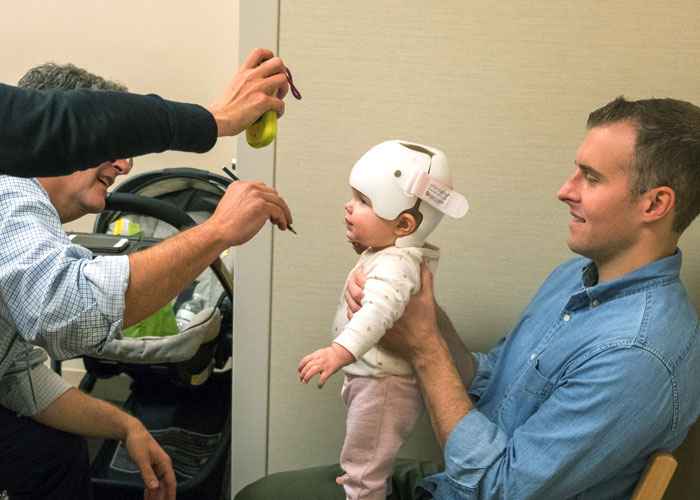3D printed helmet aids babies healing from flat head syndrome
Recently “headway” is being made around the use of 3D printing for “CranioCaps” to treat a condition in infants’ known as Flat Head Syndrome.

Nolan and Lincoln Potts wore their custom made “CranioCaps,” that were made with the help of 3-D printed molds of the boys’ heads, at Gillette Children’s Specialty Healthcare. Renee Jones Schneider, Star Tribune
by Michelle Matisons, 3Dprint.com July 27, 2015
We have heard about many groundbreaking applications of 3D printing in the medical arena — far too many to list here. Simply stated, 3D printing’s ability to produce quality products customized from body scans to the exact specifications of the patient, positions the technology to make great contributions in a variety of medical and dental applications.
In 1992, the American Academy of Pediatrics launched a campaign called “Back to Sleep” to raise awareness about placing infants on their backs while sleeping, in order to prevent Sudden Infant Death Syndrome (SIDS). While this has helped reduce SIDS cases, more and more infants now sleep on their backs — potentially leading to what is commonly called Flat Head Syndrome. Flat Head Syndrome is a condition that occurs when a baby positions his or her head the same way repeatedly. This positioning can either occur on the side or the back of the head, and over time the pressure on that part of the head flattens it.

Specialists use proprietary software from Stratasys to 3D model and then print the heads of babies with flat head syndrome at Gillette Children’s Specialty Healthcare’s Assistive Technology lab. Leila Navidi, Star Tribune
One way to correct this condition is by outfitting the babies with helmets, also known as “CranioCaps” that are custom-fitted for the babies to wear during a critical 14 week growth period. You can imagine that 3D printing can come in quite handy making these customized CranioCaps, and it has!

The 3-D printed molds used to make the custom made “CranioCaps” of Nolan and Lincoln Potts. Renee Jones Schneider, Star Tribune
9 month old twins, Lincoln and Nolan Potts, are two such lucky babies who have received support healing from Flat Head Syndrome. One got a conventionally made CranioCap, while the other receieved a 3D printed version. First it was Nolan’s turn. Gillette Children’s Specialty Healthcare, St. Paul, Minnesota, scanned Nolan’s head, emailing it to a carving company in Florida. It took about a week for the modeled head to arrive back, and work could then begin on vacuum-molding Nolan’s CranioCap.
Nolan’s twin, Lincoln, benefitted from the luck of timing, as the hospital had purchased a “$225,000, refrigerator-sized” Stratasys 3D printer by the time they were ready to start on his own CranioCap.
It took 5 hours overall: three hours to make the replica of Lincoln’s head and two to make the CranioCap. Stratasys machines make the head molds that lead to CranioCaps. The twins’ mother was delighted by the presence of 3D printing technology in her child’s treatment program, calling 3D printing “awesome” and saying she first heard about it on the television show “Grey’s Anatomy.
Gillette Children’s Specialty Healthcare reports that it treats around 1,100 children with Flat Head Syndrome annually. According to one 1996 study, this syndrome saw a dramatic rise from 1 in 300 to 1 in 60 infants diagnosed. But there is no definitive study of the rate of occurrence of Flat Head Syndrome today. Just the case numbers that Gillette Children’s Specialty Healthcare sees annually proves that the Stratasys printer will definitely be a welcomed addition at the hospital, as more babies, like Lincoln and Nolan Potts, get treated in an efficient manner with hopefully full recovery awaiting them.

A custom Gillette CranioCap® orthosis has a close fit in some areas and is open in others. As a child’s brain grows, the skull slowly molds into the open areas of the orthosis, rounding the head over time. It generally takes two to three months for this process to occur. Gillette Children’s Specialty Healthcare
Source 3Dprint.com
| References |
The “back to sleep campaign” and deformational plagiocephaly: is there cause for concern? Turk AE, McCarthy JG, Thorne CH, Wisoff JH. J Craniofac Surg. 1996 Jan;7(1):12-8.
Risk factors for deformational plagiocephaly at birth and at 7 weeks of age: a prospective cohort study, van Vlimmeren LA, van der Graaf Y, Boere-Boonekamp MM, L’Hoir MP, Helders PJ, Engelbert RH. Pediatrics. 2007 Feb;119(2):e408-18.
Objective outcome analysis of soft shell helmet therapy in the treatment of deformational plagiocephaly, Bruner TW, David LR, Gage HD, Argenta LC. J Craniofac Surg. 2004 Jul;15(4):643-50.
Long-term developmental outcomes in patients with deformational plagiocephaly, Miller RI, Clarren SK. Pediatrics. 2000 Feb;105(2):E26.
Also see
Stratasys 3-D printers ramp up health-care applications The Star Tribune
